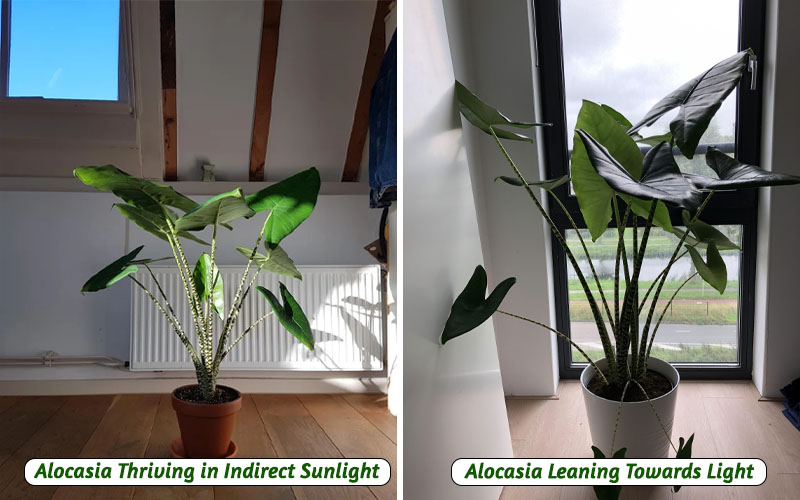If you love to collect rare exotic plants, Alocasia Zebrina is the right houseplant for you.
Native to the Philippines, Southeast Asia, Zebrina Alocasia is a rainforest plant with zebra-like stems (hence, named Alocasia Zebrina) and green leaves (similar to floppy elephant ears).
Zebrina can’t tolerate rapid temperature changes but will thrive in a hot, humid environment.
Before we move on to the alocasia plant further care, let us clear one thing:
Alocasia is not an easy-to-care-for-plant like any other houseplant ponytail palm, string of hearts, or Rosso Peperomia.
But, hey, if you know the essentials, you won’t believe how simple it can be to get your plant back in shape.
Now to the care part:
Note: Zebra plant, Zebrina Alocasia, Tiger plant, and Elephant ear are other Alocasia names.
Zebra Plant Care

The beautiful zebra-like stems and fascinating arrowy leaves make it a must-have flora for every nature-lover.
Here is the basic alocasia zebrina or tiger plant care:
Soil: Any aroid or potting soil mix (doesn’t hold moisture) with ½ diluted fertilizer
Light: Place it in a bright room with no direct sunlight
Ideal Temperature: 15°C (59°F) to 23°C (74°F)
Ideal Humidity Level: 40% to 65-70%
Watering: Water frequently (filtered water) but in small portions
You may also know them as fussy plants, which honestly, they are! So, how do you take care of Alocasia Zebrina?
Get all the information down below:
1. Soil
The soil should be well-draining, fertile, and airy that doesn’t hold excess moisture in it.
The best material for Zebrina Alocasia is aroid soil mix or potting mix with equal parts of houseplant soil, perlite, and peat moss.
You can also get 5:1:1 soil mix or any soil that is used for the monstera plant.
2. Light

“The lighter the plant color, the more sunlight it needs.” – yours truly, an Alocasia Zebrina plant parent
When it comes to light, the zebra plant can be quite tricky to handle, so if alocasia needs sun? Yes!
The key is to avoid direct sunlight, but note that these tropical plants don’t do well in low light.
So, to answer that, can alocasia grow in full sun? No, they can’t, and direct high sunlight may even scorch their leaves.
The ideal placement for this challenging houseplant is closer to a window in a bright room with indirect sunlight.
3. Temperature
Tiger plant, zebrina, loves hot and humid environment but it doesn’t do well in the high-temperature climate.
If you want to see your Alocasia plants thriving and fresh as always, avoid rapid temperature changes.
They cannot survive cold drafts or frost, nor will they do well in direct heat sources like hot radiators.
So, the ideal temperature to grow these houseplants is between 15°C (59°F) to 23°C (74°F).
4. Humidity
The tiger-striped Alocasia Zebrina Reticulata is a tropical rainforest plant from Southeast Asia which loves a high humidity environment.
According to expert Kaylee Ellen, the best practice for elephant ear plants indoors is to provide a humidity level between 40% to 65-70%.
You can say this is the optimum level they need to look healthy and fresh.
To maintain your tiger plant’s moisture, you can keep a humidifier around it or place a tray filled with pebbles and water beneath the pot.
5. Watering
If you underwater alocasia, you’ll drop a leaf. If you overwater alocasia, you still drop a leaf! Yes, it is that serious.
The most crucial thing to understand in elephant leaf plant care is its water requirements.
How often should you water the zebrina plant? Alocasia just hates to sit in wet soil. Yes, they like their soil to be moist, but they also don’t do well in high moisture.
Watering the tiger plant is not similar to others like snake houseplants.
The first tip is to water two-three times a week but in small portions. That means you should water it frequently but not altogether.
Secondly, let the top 2″ soil dry until the next watering session.
Should you mist alocasia zebrina? Or if it is acceptable to use tap water for the zebrina plant?
To answer both questions, it is a simple no!
Well, misting is your choice, but according to a plant guide, some plants are prone to diseases if you mist them, and yes, you guessed it right, your alocasia plant is one of them.
So, we leave that to you.
Now, why should you not water your alocasia zebrina with regular tap water?
Because these plants are sensitive to nutrients or minerals like chlorine and sodium in their water, so it is best to use filtered water or leave the regular water for 24 hours to remove chlorine.
6. Fertilizer
They don’t need fertilization in winter.
Sometimes, less is more! And, this suits perfectly in the case of your fussy plant. Trust us, water will do just fine for your alocasia zebrina.
You can always add later, so it is better to start with half of the directed fertilizer first and increase the amount later if needed.
The best practice is to give a ½ diluted fertilizer once a month or every two weeks during the growing season; spring-fall.
No over-fertilization equals no regret!
Alocasia is one of the rare species of the alocasia family but, don’t worry. It also comes in a variegated version!
7. Potting & Repotting
If we have to tell the exact repotting care in one line, we would say, Don’t repot often!
Why? their roots are so delicate that you might not get a chance to recover them from the damage you have caused from frequent potting and repotting.
The ideal practice is to repot after a year or two in spring and check for any root damage while doing it.
Now that you know when is the right time to repot your zebrina, you should not mess up the pot size.
Always go a size higher. The best is to use an inch larger pot than the previous one as these plants like to be a little rootbound.
8. Propagation
The next step is propagation. Alocasia tiger plants can quickly grow from bulbs to mature plants as tall as 3ft (90cm) if provided the right care.
How do you know it is time to repot or propagate the zebra plant? When you observe the roots are growing out of the pot, or the plant feels tightly rootbound.
9. Pruning
Finally, the last step in our elephant ear care guide is pruning.
To prune any yellow or damaged leaves, use a sterile knife or blade and cut closer to the main stalk.
You can either propagate using offshoots, corms, or bulbs.
Take out the plant from the pot and place it in the water to let it leave the soil or dirt (this will have minimal effect on roots).
Next, plant the corms or bulbs separately in a pot filled with well-draining soil. Try to use the same compost material for baby alocasia as you used for the parent plant.
Pro-tip: Alocasia Zebrina is a fussy and hard-to-care-for plant, so it is advisable to double the checking routine when you notice a new leaf is forming.
Dormancy Factor of Alocasia Zebrina

Zebrina alocasia goes dormant during late autumns and winters, which means its leaves start to fall, and it may look like it is dying.
But, hey, don’t panic, dormancy is just a phase!
Just move it to a warm place, increase light exposure, pressure humidity, and temperature, reduce the watering, and it will return to normal in the spring season.
Common Problems with Alocasia Zebrina & Solutions
Yellow Leaves

If the leaves of your alocasia have started to turn yellow, it is a clear signal that the sunlight is harsh or too much for the plant’s liking.
The other reason could be the inconsistent watering schedule.
The best is to place your tiger plant in a south-facing area near the window and balance the watering requirements.
Brown Tips
The main reason for the brown tips of alocasia zebrina is underwatering, which means you have caused the soil to dry out more than it was needed.
Be consistent with the watering, let the soil dry 2″ between watering schedules, and use a well-draining soil mixture.
Brown Edges Around Leaves

You are following the right watering routine and providing the proper sunlight and temperature, but still, you notice the edges around the leaves of your tiger-striped plant are turning brown.
What could the reason be? Humidity!
Make sure the humidity level is 65-70% or more than 40% around your alocasia.
Spider Mites
Mealybugs and spider mites are common pests that may infect an alocasia zebrina.
It can be due to improper care or low humidity. Wash the leaves or stem gently with warm water to get rid of the pesky bugs damaging your beautiful plant.
Leaves Curling or Drooping

Curling, bending, wilting, or drooping of the leaves or stems of the tiger plant depicts that it needs to be watered. Yes, these all are the signs of under-watering.
You can check the pot’s weight, and if it feels light, it is time to water your baby alocasia.
Note: If you notice any of the above signs, don’t water your plant immediately! Instead, feel the weight of the pot and the dryness of the soil.
Toxicity

The Zebra plant is poisonous and toxic so keep it away from the reach of children and pets. You must handle it with care as it may cause some skin irritations.
Bottom Line
With the right care, a challenging plant like Alocasia Zebrina can also come back to life.
The key to alocasia care is high humidity, no direct sunlight, adequate watering, and warm temperature.
If you do it properly, zebra plant care is really not difficult.
Okay, okay, it is. But at least you are getting a beautiful, thriving alocasia as a reward. What more do you need?
We hear you saying more houseplants!
Check Inspire Uplift blog for such stunning, rare, and gorgeous plant species.
Lastly, comment down below. Which plant guide you want to read next?
Happy planting, fellows!

